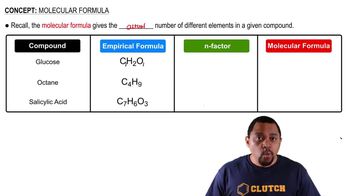Ch.22 - Chemistry of the Nonmetals

Brown15th EditionChemistry: The Central ScienceISBN: 9780137542970Not the one you use?Change textbook
Chapter 22, Problem 57
Complete the exercises below. Write a molecular formula for each compound, and indicate the oxidation state of the group 5A element in each formula: a. phosphorous acid, b. pyrophosphoric acid, c. antimony trichloride, d. magnesium arsenide, e. diphosphorus pentoxide, f. sodium phosphate.
 Verified step by step guidance
Verified step by step guidance1
Step 1: Identify the chemical formula for each compound. For phosphorous acid, the formula is H₃PO₃. For pyrophosphoric acid, the formula is H₄P₂O₇. For antimony trichloride, the formula is SbCl₃. For magnesium arsenide, the formula is Mg₃As₂. For diphosphorus pentoxide, the formula is P₂O₅. For sodium phosphate, the formula is Na₃PO₄.
Step 2: Determine the oxidation state of the group 5A element in each compound. Group 5A elements include nitrogen, phosphorus, arsenic, antimony, and bismuth. In these compounds, we are dealing with phosphorus, arsenic, and antimony.
Step 3: For phosphorous acid (H₃PO₃), assign oxidation states: hydrogen is +1, oxygen is -2. Let the oxidation state of phosphorus be x. The equation is 3(+1) + x + 3(-2) = 0. Solve for x.
Step 4: For pyrophosphoric acid (H₄P₂O₇), assign oxidation states: hydrogen is +1, oxygen is -2. Let the oxidation state of phosphorus be x. The equation is 4(+1) + 2x + 7(-2) = 0. Solve for x.
Step 5: Repeat the process for the remaining compounds: antimony trichloride (SbCl₃), magnesium arsenide (Mg₃As₂), diphosphorus pentoxide (P₂O₅), and sodium phosphate (Na₃PO₄), using similar steps to assign and solve for the oxidation states of the group 5A elements.
Key Concepts
Here are the essential concepts you must grasp in order to answer the question correctly.
Molecular Formulas
A molecular formula represents the number and types of atoms in a molecule. It is expressed using chemical symbols and subscripts, indicating the quantity of each element present. For example, the molecular formula for water is H2O, indicating two hydrogen atoms and one oxygen atom. Understanding how to derive molecular formulas is essential for identifying compounds and their compositions.
Recommended video:
Guided course

Determining Molecular Formulas
Oxidation States
The oxidation state, or oxidation number, of an element in a compound indicates the degree of oxidation or reduction of that element. It is a theoretical charge that an atom would have if all bonds were ionic. For group 5A elements, such as phosphorus and arsenic, the oxidation states can vary based on the compound, influencing their chemical behavior and reactivity. Recognizing oxidation states is crucial for understanding redox reactions and compound stability.
Recommended video:
Guided course

Oxidation Numbers
Acids and Their Formulas
Acids are substances that can donate protons (H+) in a solution, and their molecular formulas often reflect their acidic nature. For example, phosphorous acid (H3PO3) contains hydrogen ions that contribute to its acidity. Understanding the structure and formula of different acids, including polyprotic acids like pyrophosphoric acid, is important for predicting their behavior in chemical reactions and their role in various applications.
Recommended video:
Guided course

Determining Molecular Formulas
Related Practice
